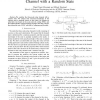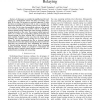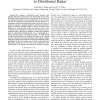135
click to vote
CISS
2011
IEEE
14 years 4 months ago
2011
IEEE
—We analyze the fundamental limits of key generation and describe an implementation based on error correcting codes. We show that key extraction based on channel coefficients si...
126
click to vote
CISS
2011
IEEE
14 years 4 months ago
2011
IEEE
—In this work we address the problem of state estimation in dynamical systems using recent developments in compressive sensing and sparse approximation. We formulate the traditio...
117
click to vote
CISS
2011
IEEE
14 years 4 months ago
2011
IEEE
—We consider the three-node relay channel with a random state. We assume that noncausal knowledge of the random state is partially known at the nodes. We present an achievable ra...
113
click to vote
CISS
2011
IEEE
14 years 4 months ago
2011
IEEE
The capacity regions of two classes of multiple access relay channels (MARes) are characterized. The MARes studied in this paper include a primitive relay component, which can he...
124
click to vote
CISS
2011
IEEE
14 years 4 months ago
2011
IEEE
—In this paper, we consider the amplified-and-forward relaying in a multichannel system with linear processing capability at the relay. We propose an analytical approach to stud...
116
click to vote
CISS
2011
IEEE
14 years 4 months ago
2011
IEEE
In this paper, we study both the jamming capability of the cognitiveradio-based jammers and the anti-jamming capability of the cognitive radio networks. We first setup the models...
127
click to vote
CISS
2011
IEEE
14 years 4 months ago
2011
IEEE
—Mobile optical wireless has so far been limited to very short ranges for high data rate systems. It may be feasible to overcome the data rate limitations over large transmission...
104
click to vote
CISS
2011
IEEE
14 years 4 months ago
2011
IEEE
— We present a hardware-accelerated implementation of a bottom-up visual attention algorithm. This algorithm generates a multi-scale saliency map from differences in image intens...
127
click to vote
CISS
2011
IEEE
14 years 4 months ago
2011
IEEE
—In compressive sensing (CS), the Restricted Isometry Property (RIP) is a powerful condition on measurement operators which ensures robust recovery of sparse vectors is possible ...
175
Voted
CISS
2011
IEEE
14 years 4 months ago
2011
IEEE
—We consider a multi-static radar scenario with spatially dislocated receivers that can individually extract delay information only. Furthermore, we assume that the receivers are...



